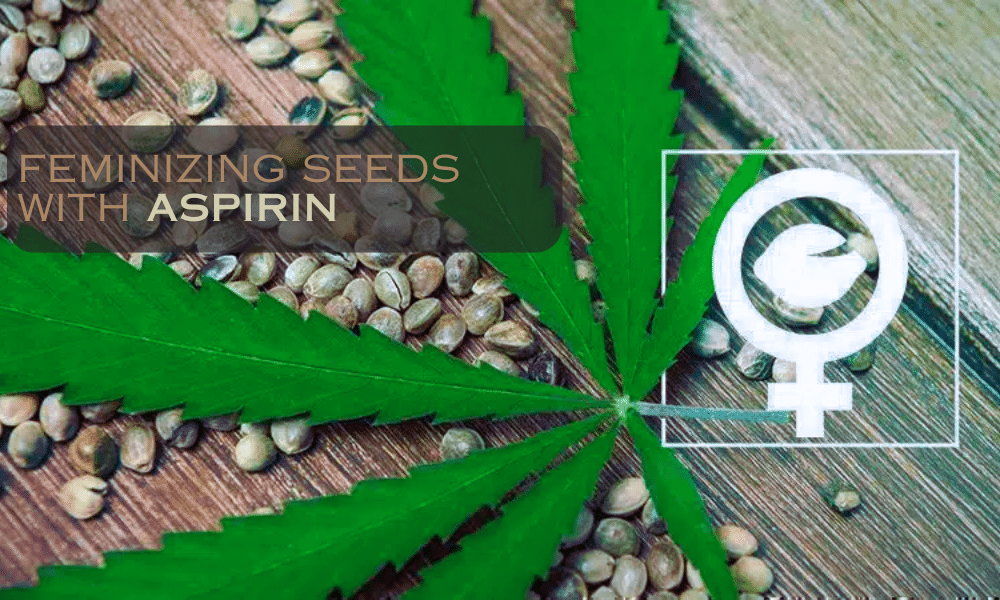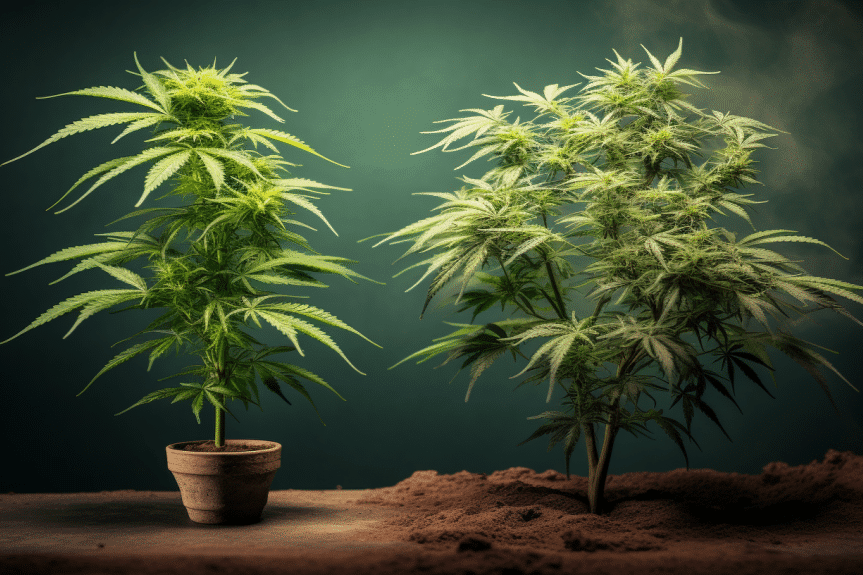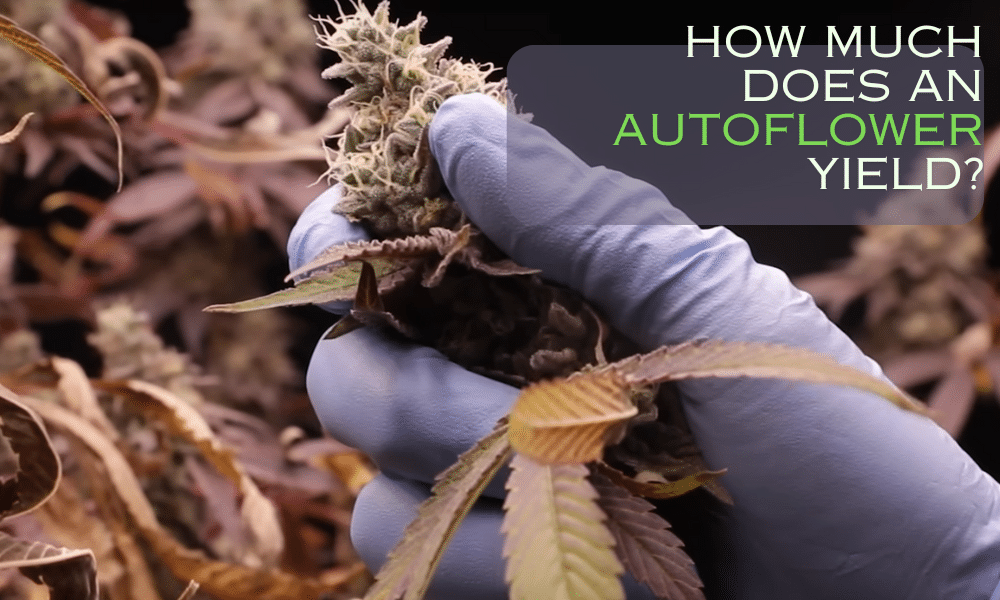No products in the cart.
Marijuana Education
How to Make Feminized Seeds with Aspirin: DIY Solution Easy At Home
You can make feminized seeds with aspirin right in your home. According to cannabis growers who are familiar with this seed feminization technique, the aspirin method of making feminized seed is less expensive, simple, and suitable for both small-scale and large-scale grows.
The Seed Fair conducted a study, surveying 500 growers to understand their motivations for choosing aspirin for feminization. Surprisingly, a majority of the respondents (approximately 57.7%) cited curiosity about alternative methods as their primary motivation. Although factors such as cost and accessibility do influence some growers’ decisions, they are notably eclipsed by the allure of trying something new.
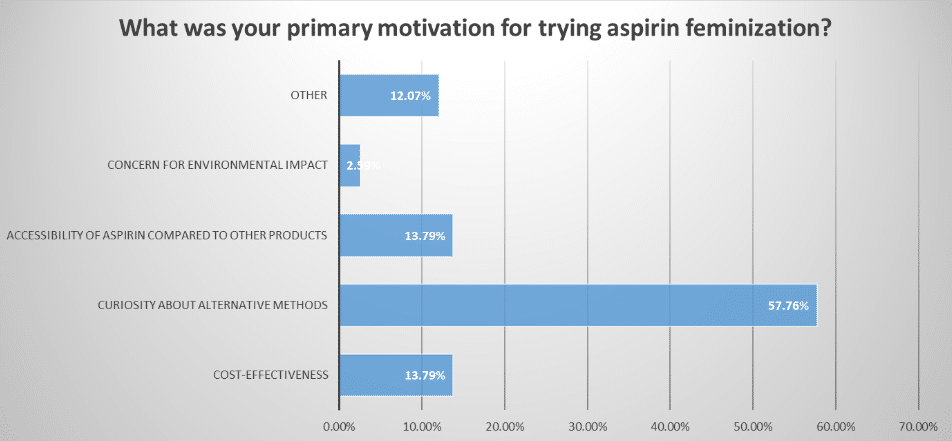
This Seed Fair DIY feminized seed making guide shares all you need to know about making feminized seeds with aspirin: the benefits and risks, and how to make feminized seeds using aspirin yourself.
Introduction to Seed Feminization and the Techniques

Seed feminization is the method used in making highly desired feminized seeds. Although this process involves pollination, its type of pollination is led by stressing the flowers to self-pollinate; thus, solving the average cannabinoid farmer’s problem.
You can make feminized seeds from both male and female cannabis flowers. However, female flowers are more reliable for making feminized seeds because they naturally contain the desired chromosomes. There are various methods of making feminized seeds. Some of the most common techniques include:
Colloidal Silver
Making feminized seeds with colloidal silver is one of the most popular and effective seed feminization methods. This technique involves using colloidal silver to inhibit ethylene production; which forces your female plants to produce male parts.
However, using colloidal silver for making feminized seeds isn’t exactly nature’s best friend due to the chemicals used. Plants treated with colloidal silver are unsafe for human consumption and should be discarded after harvesting their feminized seeds.
Rodelization
Before the chemicals, there were simpler methods to make feminized seeds, like the Rodelization or Stress technique. Rodelization is the most natural way to make feminized seeds yourself at home. It typically involves letting plants mature beyond their peak flowering time to trigger self-pollination.
The Rodelization method of making feminized seeds is inexpensive and easy to perform. However, it can be a bit of a hit-or-miss, leading to seeds with unstable genetics; seeds that may germinate weed hermies.
Silver Thiosulfate (STS)
Silver Thiosulfate (or “STS”) is a seed feminization method quite similar to the colloidal silver seed feminization technique. This method also involves inhibiting ethylene activity to trigger male parts to sprout.
Like the colloidal silver seed feminization method, the STS technique is very effective. However, it is also not eco-friendly and makes treated plant parts unsafe for human consumption. Properly discard any plant treated with silver thiosulfate after collecting its feminized seeds.
Gibberellic Acid
Gibberellic Acid (or GA3) is a plant hormone used for making feminized seeds. This seed feminization method triggers the production of male parts by tinkering with the delicate balance of other plant hormones, like auxins and cytokinins.
Growers who opt for the GA3 route to make feminized seeds are encouraged by its more reliable genetic outcomes, and thus lower risk of producing cannabis hermies. However, making feminized seeds with gibberellic acid may cause plant stretching and lead to low bud density.
Aspirin
The aspirin method of making feminized seeds is as straightforward as it sounds. It involves using the regular old aspirin to make female-only seeds.
In another poll, we asked 501 cannabis growers to find out how popular the aspirin method of making feminized seeds is. While 68 respondents indicated they had successfully feminized cannabis seeds using aspirin, a majority of the respondents (317 growers) noted they had never attempted to feminize cannabis seeds using aspirin. This data suggests that most growers are either unfamiliar with the technique or have yet to try this method for obvious reasons.
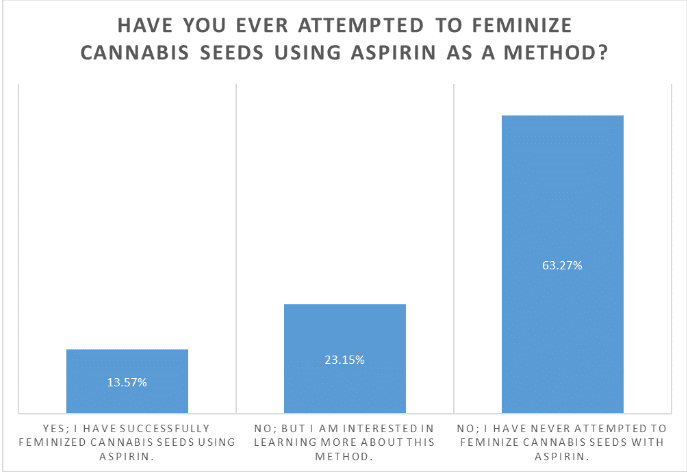
Benefits and Risks of Feminizing Seeds with Aspirin
The active ingredient responsible for making feminized seeds with aspirin is acetylsalicylic acid. When applied to female cannabis plants, this compound induces stress on the flowers and triggers the production of male parts that will produce pollen with the desired female chromosomes.
Feminized seeds are the seeds produced from the pollination of female parts with these female chromosome-containing pollen. Some benefits and risks of making feminized seeds with aspirin include:
Benefits of Feminizing Seeds with Aspirin
- A more eco-friendly technique: The aspirin method of making feminized seeds offers a much greener approach to seed feminization than methods like colloidal silver and silver thiosulfate
- Accessibility and Affordability: Required materials for this method are easily obtainable and at a low cost
- DIY Simplicity: This technique is straightforward and DIY-friendly, making it suitable for growers of all levels
- Growth and Yield Boost: Using aspirin to make feminized seeds may enhance your plant’s growth and increase your plant yields
- Stress Resistance: Aspirin-treated plants may exhibit increased resistance to disease and stress, fortifying your feminized seeds against environmental challenges and making them suitable seeds for outdoor growing
Risks of Feminizing Seeds with Aspirin
- Less predictable outcomes because of the lack of comprehensive research into the efficacy of the technique
- Overdosing your plants on aspirin can stunt growth or even result in hermaphrodite weed plants
How to Make Feminized Seeds with Aspirin: DIY Solution and Application
In a further survey of growers who indicated they had successfully tried the aspirin seed feminization, we found that most growers (28 of 68 respondents) use an aspirin solution concentration of 100 to 200 pm to make feminized seeds.
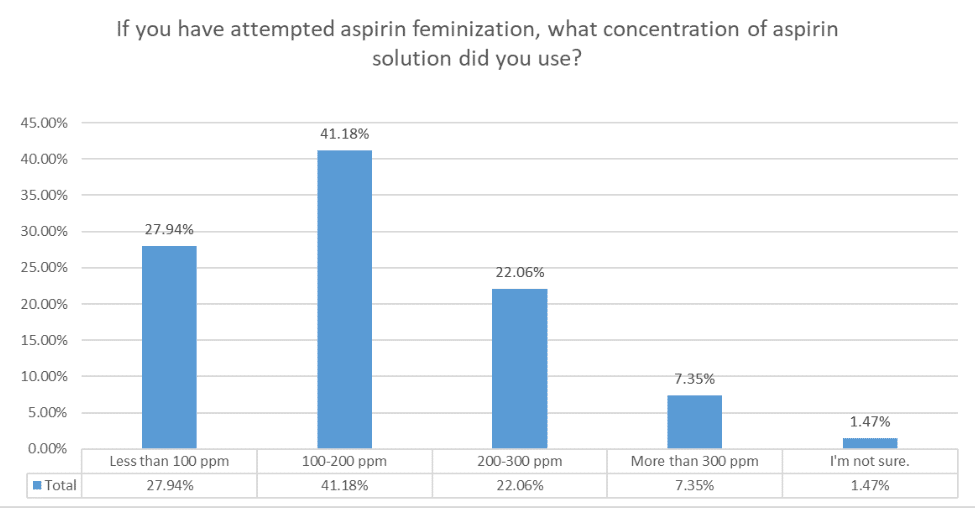
Materials needed for this DIY solution and application guide are commonplace in homes or neighborhood stores:
Materials needed:
- Spray bottle
- Distilled water
- Uncoated aspirin
- Measuring cup
Preparing the Aspirin Solution
Method 1:
- Crush 100 to 200 mg of pure uncoated aspirin using a pestle or similar tool until fine.
- Stir the crushed aspirin into one kg of room-temperature distilled water until dissolved. You may sieve out undissolved residues or particles using a fine mesh strainer.
- Transfer the aspirin solution to the spray bottle for easy application.
Method 2: For a fertilizing aspirin solution
- Let the aspirin sit in distilled water for 24 hours to dissolve.
- Add ½ teaspoon of sodium nitrate per quart to the mixture.
Application of the Aspirin Solution to Make Feminized Seeds
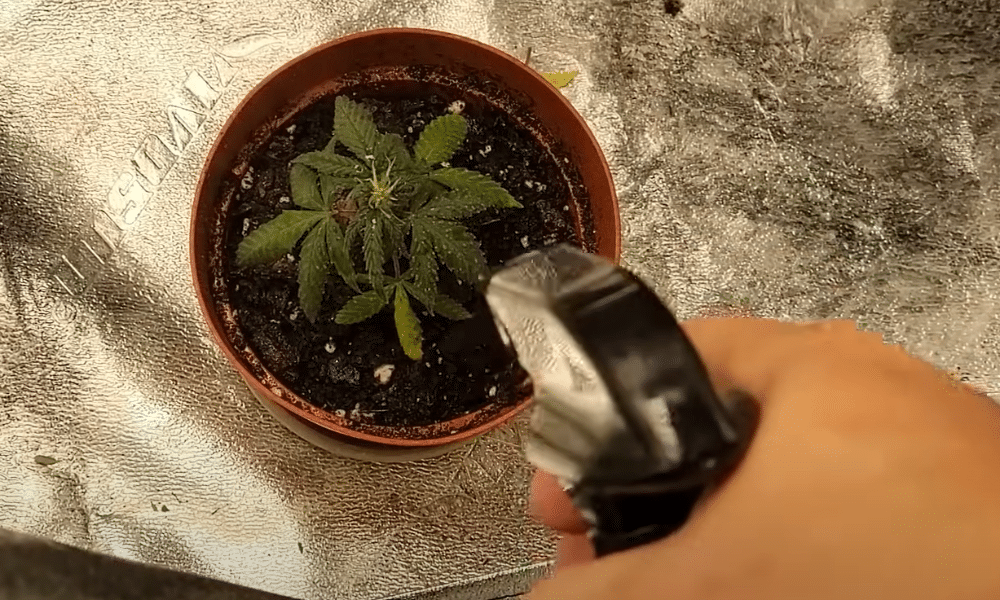
- The ideal time to use the aspirin treatment is as soon as the pre-flowering stage begins, between 4 and 6 weeks after germination
- Apply the aspirin solution three times every 7 to 10 days to achieve the desired results
There are two ways to apply the aspirin treatment when making feminized seeds: The foliar method and the root-drenching technique.
- Foliar Method: Spray the upper and lower parts of leaves and stems with the solution using a fine mist spray bottle.
- Root-drenching Method: Pour the aspirin treatment into the plant’s grow substrate to soak the roots.
The foliar method of using the aspirin treatment is most suitable for beginner growers and minimizes the risk of overdosing or moisture-related issues, like root rot.
Pollinating and Collecting the Feminized Seeds
- Look for male parts, such as pollen sacs, sprouting from your female plants 2 to 3 weeks into pre-flowering
- Wait till the pollen sacs look swollen, then collect pollen by placing a bag over the plant and shaking the entire structure
- Transfer pollen to the female parts using a soft brush
Your female plants should produce feminized seeds at harvest since the pollinating male pollen carry female chromosomes.
What to Consider When Using Aspirin for Making Feminized Seeds (Tips for Success)
- Source Quality Seeds: Start strong by selecting healthy seeds from reputable breeders. Quality seeds lay the foundation for success when using aspirin for making feminized seeds.
- Timing Matters: Do not apply the aspirin treatment during extreme heat or dry periods. Early mornings and late afternoons are the best time to use the aspirin treatment on your plants for optimal absorption and results.
- Perfect Your Solution: Prepare your aspirin solution to a concentration of 100 to 300 ppm (parts per million).
- Regular Monitoring is Key: Keep a watchful eye on your plants for signs of hermaphroditism or stress damage
- Safety First: Prioritize safety throughout the aspirin treatment process; from preparation to application and disposal. Store aspirin and prepared solutions safely away from children and pets, and adhere to all safety guidelines.
- Record and Adapt: Keep detailed records of your plant’s response to note adverse reactions early and make informed adjustments and improvements.
- Legal Compliance: Respect local laws and regulations regarding the use of aspirin or other substances for cannabis cultivation
Alternatively, you can explore our selection of cultivation-ready feminized seeds crafted from female flowers.
FAQ Section
How does aspirin feminize cannabis seeds?
Aspirin induces stress and feminizes cannabis seeds by regulating levels of the hormone, ethylene.
What concentration of aspirin should I use for feminizing seeds?
Most cannabis growers use an aspirin concentration of 100 to 200 ppm for feminizing seeds.
When should I treat the seeds with aspirin?
Treat seeds with aspirin as soon as they enter the pre-flowering stage for the best results.
How long does it take to see results after treating seeds with aspirin?
Results with this seed feminization method typically appear within a few weeks after treatment but may vary with strain, growing conditions, and application frequency.
Can aspirin feminization guarantee 100% female plants?
Aspirin feminization may not guarantee 100% female plants; success rates depend on genetics and other factors.
Can I use any type of aspirin?
Pure, uncoated aspirin reportedly yields the best results for feminizing seeds.


